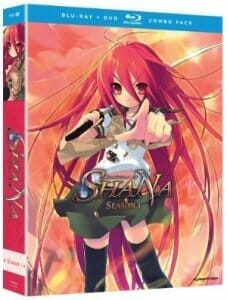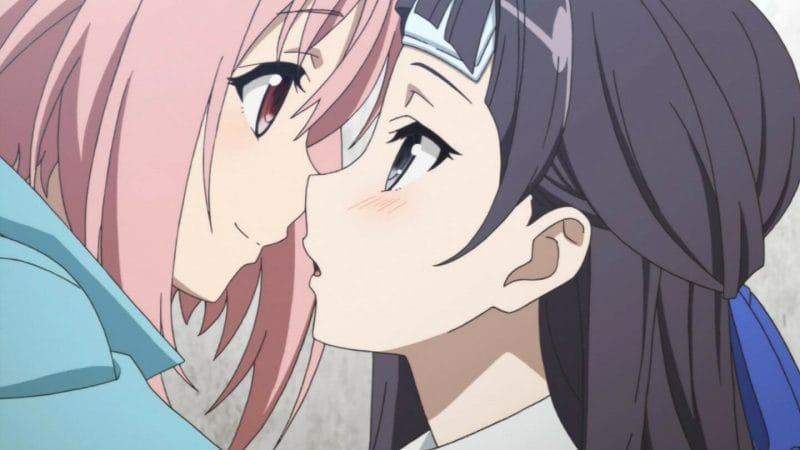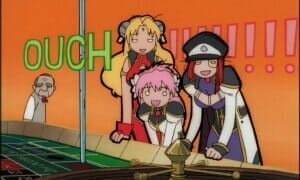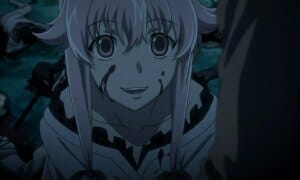 Let’s face it. Themes like male virginity have long been commonplace in anime. Industry writers and directors are never going to stop finding new ways to build a story on appealing to this. We even see that in the west, with the increasing visibility of the Manic Pixie Dream girl trope and the satirization thereof. Shakugan no Shana gives us another of these boy-meets-girl stories, where they rather literally drop the heroine on our bland hero, who’s quite aware of how typical his life is.
Let’s face it. Themes like male virginity have long been commonplace in anime. Industry writers and directors are never going to stop finding new ways to build a story on appealing to this. We even see that in the west, with the increasing visibility of the Manic Pixie Dream girl trope and the satirization thereof. Shakugan no Shana gives us another of these boy-meets-girl stories, where they rather literally drop the heroine on our bland hero, who’s quite aware of how typical his life is.
While hardly a new concept – going all the way back to the ’80s, the likes of Ah! My Goddess say hi – in recent years, the magic girlfriend anime subgenre has bloomed into something more prominent, often laden with fanservice. Some shows have no qualms about getting all the lead girls completely naked in their opening sequences, just to let viewers know what the show’s really about in the first place. Preceding this more recent trend, Shakugan no Shana, thankfully, is not one of these shows.
The story begins with high school student Yuji Sakai, narrating about his daily life – one like any other. Sound cliche? You bet it is. Then we get to the hook – on the way home from school, space distorts and Yuji finds himself under attack by freakish monsters from another dimension. One of them is a head with a few too many faces, and the other’s a giant baby. This show makes another good argument for why you should all hate babies. As if you really needed yet another reason. At any rate, these are Rinne, the minions of the show’s antagonists, the Crimson Denizens. And they’re about as close to nightmare fuel as the show’s monsters get. They don’t last long, either, as a flame-haired girl in a cape shows up and makes short work of the beasts with her sword. There’s probably a lesson in there somewhere about screwing with redheads.
Following the preceding battle, Yuji finds himself torn open – curiously lacking in any of the expected accompanying blood or gore – yet still alive. Shana fixes him up, then replaces all the people who died in the sealed space where the battle took place with Torches, which was what Yuji had now become. As the would would face terrifying disruption by the sudden and abrupt deaths of numerous people, Flame Hazes like the girl replace the deceased with Torches. These are unobtrusive stand-ins for the deceased who quietly fade from the awareness and memory of those around them before disappearing entirely. The victims of the Crimson Denizens and their minions quietly disappear from the world without anybody noticing. It’s a pretty wistful way to go.
The Flame Haze girl minces no words in revealing to Yuji that the boy known as Yuji Sakai was now dead, and that who he was now was nothing more than the boy’s leftover scum. Once his remaining power of existence – visible as a diminishing flame, as in all Torches – was snuffed out, the world would forget he had ever existed. Shakugan no Shana begins with a storyline just a wee bit darker than your garden variety high school show.
Yuji, shaken as anybody would be within his new circumstances, takes a little while to process the reality of his grim new circumstances in the following episodes. The Flame Haze girl, soon named Shana by Yuji – after her sword, the Nietono no Shana – sticks by Yuji. He’s a living treasure chest, it turns out, known as a Mystes. Valuable bait for Crimson Denizens.
When our first villain takes the bait, by the books pretty-boy Denizen Friagne the Hunter emerges, seeking to add Yuji’s treasure to his collection before destroying all of Misaki City in a ritual to bring Marianne, the doll Rinne he loves, fully to self-sustaining life. Over the course of this story, we also meet the mysterious Denizen Lamies the Corpse Collector and Margery Daw, a traumatized and aggressively bloodthirsty Flame Haze with a big-sisterly older-woman appeal and a ravenous alcohol molar, to put it in John Hodgman terms. When the bad guys fall and the nature of Yuji’s treasure is revealed, it’s then that the story really begins. It’s also pretty much this first major story arc that sets the tone for the show and determines whether or not you’ll enjoy it.
The arcs that follow in this first season go from resolving a rivalry between the two Flame Hazes over the question of which Denizens deserve to die, to Shana beginning to soften and develop an affection for our logical and moralistic Mystes, to even a token pool episode. Introduced as a pretty prototypical tsundere, we watch as Shana goes from being all tsun tsun to tapping into the power of dere dere to realize her true ability. If you understood what that sentence meant, you’re probably questioning everything in your life, much like I am now. If I drank, this would be one of the reasons why.
The major villains – especially earlier in this first season – will have you asking, “What the hell am I watching?” They range from the aforementioned creepy doll fetishist to a pair of uncomfortably young-looking incestuous siblings who totally make out all the time. With tongues and everything. Where are your John Hughes style teen angst laden revelations about life NOW, Shana? And then, after some flashback episodes detailing Shana’s early training as a Flame Haze – that also introduces us to Wilhelmina Carmel, Shana’s stony Flame Haze caretaker and mentor, who always wears a stereotypical maid outfit to tick another of the show’s fetish boxes – a big bad nasty syndicate full of fairly typical but appreciably creative bad guys, the Ball Masque, emerge to pretty literally rain on everybody’s parade. You’ll get what I mean by this if you watch it.
Along the way, Yuji’s quiet classmate Kazumi, who carries an undying adolescent love for Torch boy, stumbles into the Crimson World conflict after coming into contact with a traveling Flame Haze late into the season. She goes from not only functioning as a romantic rival to Shana, but also a relatively useless character whenever trouble strikes Misaki City. Sort of a distaff counterpart, in that regard, to two of their other classmates, delinquents Sato and Tanaka, who hook up with Margery early on – and not in a sexy sense – and end up wanting to follow their new big sister to the ends of the earth, even though they’re completely worthless in a fight with anything from the Crimson World. At least they get to play long distance support – Kazumi doesn’t even get that.
It’s easy to call Shakugan no Shana fairly derivative in that many of its included ideas are in no way new to a viewer of anime or even modern nerd-oriented television. The show precedes Kaze no Stigma, which aired at the same time as Shana season 2, and co-starred a teenage fire magic-using swordswoman. And in recent years, we’ve seen more redhead magic girlfriends in anime, such as in the significantly more dirty High School DxD and So I Can’t Play H. Likewise, the badass ass-kicking girl lead has been a pretty common trope for some time – hats off to Joss Whedon – and we’ve seen the monster of the week plots forever. All of this is part of the Shakugan no Shana experience.
Where Shana sets itself apart from its contemporaries is in both its sometimes-pervasive morbidity – especially early on – and that as the show continues, it goes above and beyond its concept, taking the time to more fully explore its characters and universe without becoming overly bogged down in its own lore. There’s no answering the question of why it’s the Crimson World, or why all the fire imagery, or why we’re not seeing any other corresponding universes. In Shakugan no Shana, they created an essential equivalent to Yu Yu Hakusho‘s Makai and the general netherworld/underworld monster invasion cliche. They saw that old concept and decided to paint it red. As such, I liken Shakugan no Shana to being “Cute Cute Hakusho.”
Shana’s transformation and development over the course of the show are fun, and her affection for Yuji is believable, even if her inward softening is a little sudden. She’s been isolated and kept completely separate from the human world for so long that she never really learned how to be human, in a manner of speaking. It’s only once Yuji gets under her skin and annoys her enough that she finally starts to take an interest in existence beyond that of her duties as a Flame Haze. Yuji himself defies the usual milquetoast high school protagonist cliche – especially as a protagonist in the middle of a love triangle – by actually having more of a personality and actual talent outside of being good at violence. He’s moral, sometimes to an irritating fault, but possesses logical and observative qualities that make him increasingly indispensable to the Flame Hazes. There are a lot of tropes – and some fetish material – at work in Shakugan no Shana‘s character writing, but nearly all of these characters manage to rise above these tropes to varying degrees, which makes them very difficult to dislike.
Another appreciable aspect of Shakugan no Shana is its willingness to toss a lot of reversals of cliche gender roles at the viewer. The show’s tough-as-nails fighters are all ladies, and the one male Flame Haze who appears at all receives the least screen time, almost none of which he spends fighting. The nature of the ladies’ combat isn’t exploitative, either, in appreciable contrast to the loathsome and misogynistic likes of Ikki Tousen, where combat itself is a sort of fetish, and an exercise in tearing the girls’ clothes off. In Shakugan no Shana, there are no battles that end with the girls nude or near nude. The show is, in fact, largely bereft of unnecessary fanservice, outside of the occasional bouncing bosom moment given to Margery Daw.
When Denizens arrive and it’s battle time in Misaki City, the ladies set out to fight, but the guys are largely relegated to supporting roles. Sato and Tanaka would be easy prey for any Denizen if they made their involvement known. They spend most of the first season at villain Friagne’s crystal altar within his abandoned lair, utilizing its detection capabilities to help Margery from afar. Yuji, on the other hand, often tends to be too close to the action for his own good, as in over his head as he can be as a mere Mystes. Still, rather than brute strength, it’s his quick thinking, talent with logic, and remarkable perceptiveness that not only come to define him in many ways as a character – ensuring that he doesn’t languish as a bland lead – and it’s this aptitude of his that makes him invaluable at Shana’s side. Much of his character arc, even going beyond the first season, focuses on his continued efforts not to be any kind of liability to Shana and the other slayers as he drifts from his world toward someplace much more mysterious and menacing.
Considering all the outside references made here, Shakugan no Shana is a lot of things. It’s part Buffy the Vampire Slayer, it’s part Yu Yu Hakusho, all the way down to the early protagonist death, and it’s part light-hearted high school rom-com. There’s so much about it that’s unoriginal in a sea of unoriginal anime, it’s genuinely pleasantly surprising that the show does so much to overcome its reliance on cliches and tropes, and that it manages to be as well balanced as it is. In many ways, the show’s greatest weakness is its terminology bloat, as evidenced by the content of this review – be glad I didn’t try to make sense of “Tool for Destruction Attack” anywhere here – but once you get past all the new terms the show introduces for everything, what you have is a very familiar, yet still fresh feeling show that’s often surprisingly morbid, packed with enjoyable action, and gives you a cast of characters it largely treats with respect and dignity. All that despite some of the more fetishistic aspects worked into the show’s base character design.
At heart, Shakugan no Shana is a genuinely good show. It stops short of greatness, due to its overreliance on the tried and true tropes that make up so much of its backbone. But you don’t watch Shakugan no Shana for its tropes – you watch it because of the genuine respect and affection the show has for its characters, and because once you get past the terminology bloat, the new world Yuji’s ventured into with Shana is one of intrigue, where mere brute force alone won’t get you anywhere. Besides, it’s pretty hard to hate a show that begins with its cute little heroine announcing to the male protagonist, “You are already dead.”











